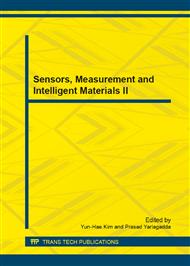[1]
S. C, Chuang, Shih F. Y., and. Slack M. R. Machine recognition and representation of neonatal facial displays of acute pain, Artificial Intelligence in Medicine 36(2), 2006, pp.211-222.
DOI: 10.1016/j.artmed.2004.12.003
Google Scholar
[2]
S. Brahnam, C. Chuang, S. S Randal, and Y. S Frank. Machine assessment of neonatal facial expressions of acute pain, Decision Support Systems 43, 2007, pp.1242-125.
DOI: 10.1016/j.dss.2006.02.004
Google Scholar
[3]
S. Brahnam , L. Nanni, and S. Randall. Introduction to neonatal facial pain detection using common and advanced face classification techniques, Advanced Computation Intelligence Paradigms in Healthcare, 1, Studies in Computational Intelligence (SCI) Series: Springer-Verlag, Berlin, 48, 2004, pp.225-253.
DOI: 10.1007/978-3-540-47527-9_9
Google Scholar
[4]
S. Brahnam, F. C Cgao, Y. S Frank, and R. S Melinda. SVM classification of neonatal facial image of pain, Proceedings of the 6th International Workshop on Fuzzy Login and Applications (WILF05).
Google Scholar
[5]
S. Brahnam and L. Nanni , Neonatal facial pain detection using NNSOA and LSVM, Proceedings of the International Conference on Image Processing, Computer Vision, and Pattern Recognition (IPCV08), Las Vegas, vol. 2, 2008, pp.352-357.
Google Scholar
[6]
L. Nanni, S. Brahnam, A. Lumini. A local approach based on a local binary patterns variant texture descriptor for classifying pain states., Expert Systems with Applications 37(11) pp.7888-7894.
DOI: 10.1016/j.eswa.2010.04.048
Google Scholar
[7]
S. Brahnam, C. F. Chuang, F. Y. Shih, and M. R. Slack, SVM classification of neonatal facial images of pain, Fuzzy Logic and Applications, Isabelle Bloch, Alfredo Petrosino, Andrea G. B. Tettamanzi, editors, Lecture Notes in Computer Science, 3849, pp.111-115.
DOI: 10.1007/11676935_15
Google Scholar
[8]
K. Pun, and Y. Moon, Recent advances in ear biometrics., pp.144-149, (2004).
Google Scholar
[9]
C. Rafael Gonzalez, E. Richard Woods and L. Steven Eddins (2004). Digital Image Processing using MATLAB. Pearson Education. ISBN 978-81-7758-898-9.
Google Scholar
[10]
Spence K., Gillies D., Harrison D., Johnston L., Nagy S. A. Reliable pain assessment tool for clinical assessment in the neonatal intensive care unit. J Obstet Gynecol Neonatal Nurs. 2003; 34: 80-86.
DOI: 10.1177/0884217504272810
Google Scholar
[11]
Cignacco E., Mueller R., Hamers J.P.H. , Gessler P. Pain assessment in the neonate using the Bernese Pain Scale for Newborns. Early Hum Dev. 2004; 78: 115-121.
DOI: 10.1016/j.earlhumdev.2004.04.001
Google Scholar
[12]
Lawrence J., Alcock D., McGrath P., Kay S., MacMurray S. B., Dulberg D. The development of a tool to assess neonatal pain. Neonatal Netw. 1993; 11: 59-66.
Google Scholar
[13]
Krechel S.W., Bildner J. CRIES: a new neonatal postoperative pain measurement score. Initial testing of validity and reliability. Paediatr Anaesthesiol. 1995; 5: 53-61.
DOI: 10.1111/j.1460-9592.1995.tb00242.x
Google Scholar
[14]
Stevens B., Johnston C., Petryshen P., Taddio A. Premature Infant Pain Profile: development and initial validation. Clin J Pain. 1996; 11: 12-22.
DOI: 10.1097/00002508-199603000-00004
Google Scholar
[15]
Hummel P., Lawlor-Klean P., Weiss M.G. Validity and reliability of the N-PASS assessment tool with acute pain. J Perinatol. 2009: 1-5.
DOI: 10.1038/jp.2009.185
Google Scholar
[16]
Hummel P., Puchalski M., Creech S. D., Weiss M. G. Clinical reliability and validity of the N-PASS: neonatal pain, agitation and sedation scale with prolonged pain. J Perinatol. 2008; 16: 55-60.
DOI: 10.1038/sj.jp.7211861
Google Scholar
[17]
Hu, M. K., 1962. Visual pattern recognition by moment invariants, IRE Transactions on Information Theory, Vol. 8, pp.179-187.
DOI: 10.1109/tit.1962.1057692
Google Scholar
[18]
G.J. Klir, B. Yuan, Fuzzy Sets and Fuzzy Logic: Theory and Applications, Prentice-Hall, Englewood Cliffs, NJ, (1995).
Google Scholar
[19]
Pasi Luukka: Similarity classifier using similarity measure derived from Yu's norms in classification of medical data sets. Comp. in Bio. and Med. 37(8): 1133-1140 (2007).
DOI: 10.1016/j.compbiomed.2006.10.005
Google Scholar


